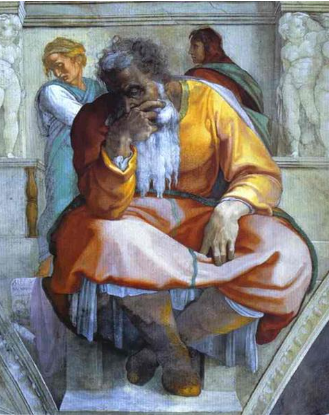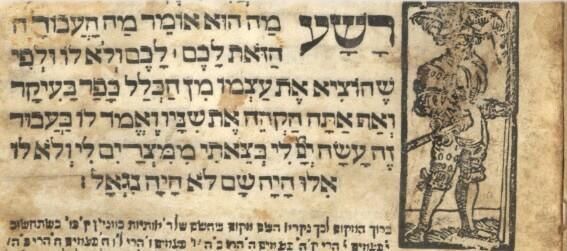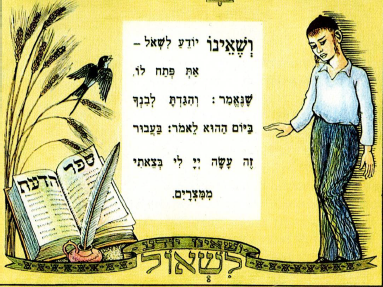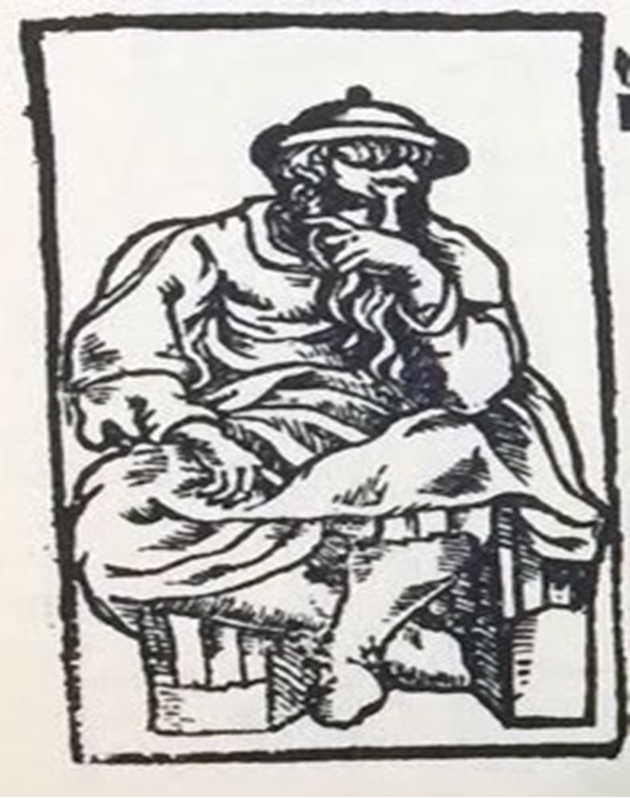The Passover Haggadah has many virtues. It is the Hebrew manuscript that has received the most commentaries, second only to the Bible. It is also the most illustrated book in the Jewish library. These illustrations, even more than the commentaries, express in a focused manner the worldview of those for whom they were made, and through the illustrations the Haggadot also strengthened and perpetuated their messages to future readers. As a result, many illustrations have both historical and current relevance at the same time.
The medieval evil soldier
Among the four sons appearing at the beginning of the Haggadah, the most fascinating is the wicked child. According to the text, he is somewhat ambivalent and estranged from his family, his people and his heritage, yet he has not completely severed ties with them.
However, throughout the generations, illustrators weren’t fooled by him. The wicked son is always a wayward son whose intentions are aimed at the destruction of the people of Israel and the Torah. Therefore, almost without exception, he was depicted as a soldier until the end of the 19th century.
Choosing a soldier was natural in those days. In order to become a soldier in medieval times, a Jew had to convert his religion, betray his people, and join the enemy that had been persecuting him for centuries. The soldier played a central role in carrying out harsh decrees against the Jews, starting from the Rhineland massacres and onward.
A converted soldier, like "his fellow" who became a church father, sought to prove himself to his new audience (and perhaps to himself) through his religious zeal and his commitment to persecuting his former brethren.
In short, the soldier symbolized the threat to every Jewish mother and the embodiment of wickedness for every Jew. Despite the fact that the wicked has taken on additional forms in the Haggadahs in recent centuries (Marxists, assimilationists, members of the Yevsektsiya, and more), the simile between traitors from within and those donning military uniform has remained in the Jewish perception and imagination.
Today, there are those who refer to IDF soldiers in this way and refuse to depart from this conception, which deserves condemnation.
The mystery of the child who doesn't know how to ask
The child who doesn't know how to ask isn’t only mute, he is also a mystery. Why can't he ask? Some thought he was too young to ask for himself, so they depicted him as a small boy. Others assumed he was intellectually challenged. It was understood by all that the Haggadah's instruction was meant to draw him into the story of the Exodus and the covenant with God in accessible terms.
With the establishment of Israel, various secular bodies (especially in the kibbutz sector) printed Haggadahs that expressed their values (freedom, nationalism, labor, military service, peace and more), while maintaining a connection to Jewish tradition.
A closer look at these Haggadahs reveals that they not only turned the tradition on its head but also expressed sharp opinions that still stand at the center of contemporary debates.
In this way, Livni explicitly declared what many among those demanding the inclusion of core studies in ultra-Orthodox schools (a demand that is fully justified from a Torah perspective) are saying silently. ears in a cheder and knows a wide array of Jewish religious and commentary texts by important rabbis - yet he is challenged educationally and culturally.
What he lacks, and probably tempts him, is right in front of him: the “Book of Knowledge" ("Science" would have been more appropriate). That book, presented as a sacred codex written with a quill, promises the child prosperity, if he abandons his world and joins it.
In this way, Livne explicitly declared what many among those demanding the inclusion of core studies in ultra-Orthodox schools (a demand that is fully justified from a Torah perspective) are saying silently.
In their eyes, "enlightenment" and "science" aren’t just means of integrating people into society and the economy and for broadening horizons, while considering their other values; they’re intended to be a substitute for the Torah.
The mystery of the Jewish hat
Let's be honest, the wise child is the least interesting of them all. He's mom and dad’s golden child. He wins the annual Talmudic competition. He's the one who checks the lettuce, measures the matzah portions, and the measures of the cups you drink. There's no one more Jewish than him.
Therefore, in light of his clear-cut ultra-Orthodox image, it was interesting to know what Christian printer Giacomo Rufinelli and his Jewish editor Rabbi Isaac ben Samuel Bassan meant when they attributed to the wise child a painting of an aged and pensive Jew wearing a "Jewish hat." But as many know today, the painting is a rough copy of Michelangelo Buonarroti's depiction of the prophet Jeremiah on the ceiling of the Sistine Chapel.
Rufinelli and Ben Samuel, however, didn't have to travel to Rome to see the image. As I learned from my colleague Professor Ilia Rodov from the Department of Jewish Art at Bar-Ilan University, woodcuts with such figures were offered for sale to any printer. So, Rufinelli and Ben Samuel simply took the image, put a Jewish hat on the head of the character - and voila: a wise (elderly) child who pleases his Jewish father!
But what did Jews who bought the Mantua Haggadah (or its many copies) think and did they indeed know the Christian origin of the illustration? It's hard to say. I believe the current case is important because it raises and emphasizes a fundamental question about the connection between Jewish heritage and cultures outside of it.
For example, some may passionately argue that all of Judaism is the adoption of foreign content and its dressing is done to fit the Hebrew religion. Others may say that despite the fact Judaism has its own character, it sometimes needs to include more contemporary external content.
On the other hand, there’s the opinion of the Islamic researcher Sir Hamilton Gibb. In order for a religion to absorb external influence, he argued, three conditions must be met: 1. An internal need that arises independently; 2. Adapting the absorbed content to the basic values of the assimilating religion; 3. Ascribing an internal-religious meaning to the absorbed content. In my opinion, if the reproduction of Michelangelo's painting passed without criticism, I’m convinced it was mainly because it met all the conditions set by Gibb.
5 View gallery


Michelangelo Buonarroti's depiction of the prophet Jeremiah on the ceiling of the Sistine Chapel
And what about the simple child?
Let's conclude with a few words about the simple child. The truth is that the illustrators and interpreters struggled to define him. Some depicted him as a young child who has not yet come of age. Others assumed he was mentally challenged. A third group interpreted the word "simple" according to the verse: "Be wholehearted with the Lord your God." But there’s a common thread binding all of them.
They all have the ability to feel and react, without nuances and without excessive cleverness, not only to the importance of the Passover Seder but also to the magnitude of the miracle of the exodus and the survival of the Jewish people for thousands of years, whose birth lies at the heart of the holiday. In these troubled times, perhaps it's worthwhile for all of us to be simple.





